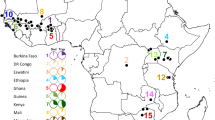Abstract
IN 1951 we found in Glossina brevipalpis from the Institute of Scientific Research in Central Africa's Mosso field station, Burundi, north-east of Lake Tanganyika, a trypanosome infection of the salivary glands similar to that noted by Burtt in 1942 near Amani, Tanganyika. Our rate of infection was very low; two infected flies out of 700 dissections of salivary glands (0.28 per cent) as compared with the low rates found also by Burtt (0.84 per cent), by Whitnall in 1934 (0.62 per cent) and by Brown in 1938 (1.14 per cent). Elsewhere we have stated1 regarding the salivary gland infections that “we do not believe that this trypanosome is necessarily a polymorphic one as assumed by Burtt. Its morphology might be completely different from the trypanosomes of the salivary glands in G. palpalis and G. morsitans”. As many as 6,397 G. brevipalpis were examined during the period April 1952–April 1953 by E. Peel and M. Chardome in our laboratory. They discovered 1.09 per cent infection of the salivary glands and isolated strains which when transmitted cyclically to domesticated pigs, showed a monomorphic trypanosome identical with T. suis Ochmann. This trypanosome was originally recorded in East Africa, first by Ochmann (1905) from the domestic pig, and later in 1912 by Geisler and Mayer from the warthog: all these authors gave an inadequate description of this trypanosome. Preparations showing T. suis from the Congo were demonstrated by L. van den Berghe2 at a laboratory meeting of the Royal Society of Tropical Medicine and Hygiene in January 1954, and it was finally adequately described by Peel and Chardome in 19543 (preliminary announcement in 19534) and its revival announced by Hoare the same year.
This is a preview of subscription content, access via your institution
Access options
Subscribe to this journal
Receive 51 print issues and online access
$199.00 per year
only $3.90 per issue
Buy this article
- Purchase on Springer Link
- Instant access to full article PDF
Prices may be subject to local taxes which are calculated during checkout
Similar content being viewed by others
References
van den Berghe, L., and Lambrecht, F. L., “Observations biologiques sur Glossina vanhoofi”, Folia. Sci. Afric. Centr., 2, No. 4 (1956).
Peel, E., and Chardome, M., Trans. Roy. Soc. Trop. Med. Hyg., 48 (1954).
Peel, E., and Chardome, M., Ann. Soc. Belg. Med. Trop., 36 (1954).
Peel, E., and Chardome, M., Ann. Soc. Belg. Med. Trop., 33 (1953).
Lovemore, D. F., Un rapport preliminaire sur les resultats de repas sanguins de tsetses recueillis a Kariangwe, vallee de la riviere Lubuh, Juin 1951 a Mai1952. Bureau Permanent Interafricain pour la Tsetse et la Trypanosomiase, Publ. No. 208.
Weitz, B., and Jackson, C. H. N., “The Host Animals of Glossina morsitans at Daga-Iloi”, Bull. Ent. Res., 46, Part 3 (1955).
van den Berghe, L., and Lambrecht, F. L., “Preliminary Note on the Biology of Glossina vanhoofi Henrard”, Bull. Ent. Res., 49, Part 3 (1958).
van den Berghe, L., Peel, E., and Chardome, M., “Les infections a Trypanosomes transmises par Glossina vanhoofi dans le region d'lrangi”, Folia Sci. Afric. Centr., 2, No. 4 (1956).
Author information
Authors and Affiliations
Rights and permissions
About this article
Cite this article
VAN DEN BERGHE, L., ZAGHI, A. Wild Pigs as Hosts of Glossina vanhoofi Henrard and Trypanosoma suis Ochmann in the Central African Forest. Nature 197, 1126–1127 (1963). https://doi.org/10.1038/1971126a0
Issue Date:
DOI: https://doi.org/10.1038/1971126a0
Comments
By submitting a comment you agree to abide by our Terms and Community Guidelines. If you find something abusive or that does not comply with our terms or guidelines please flag it as inappropriate.



